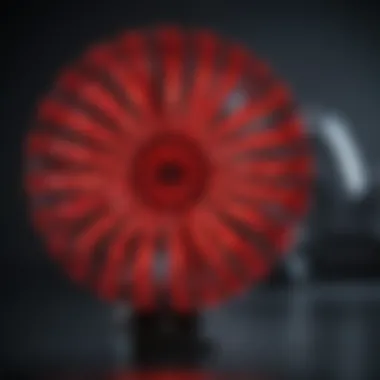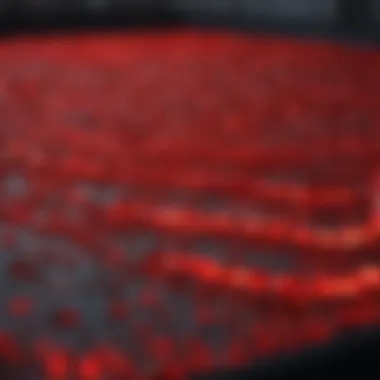Exploring 660 nm Red LED Technology for Applications


Intro
The exploration of 660 nm red LED technology reveals a significant aspect of modern advancements in lighting and its applications across various scientific disciplines. Red LEDs emitting light at the 660 nanometer wavelength have garnered attention due to their unique properties, playing a pivotal role in both agriculture and medical fields. Understanding their molecular principles enhances our grasp of how these LEDs can optimize growth in plants and facilitate therapeutic interventions.
This article provides a systematic examination of these LEDs, delving into their operational mechanisms and implications. The discussion will cover fundamental characteristics of 660 nm light, its impact on photosynthesis, horticulture, and various medical applications. With scientific advancements in LED design, this range of red light has shown promise in a myriad of applications, from indoor gardening to phototherapy.
Research Highlights
Overview of Key Findings
660 nm red LEDs are effective in promoting plant growth by optimizing processes like photosynthesis, making them a preferred choice in horticulture. Furthermore, the therapeutic uses of red light in areas such as wound healing, pain relief, and skin rejuvenation have spearheaded relevant research. Technological advancements have improved the design of these LEDs, enhancing their efficiency and effectiveness across applications.
Significance of the Research
The exploration of 660 nm red LED technology illustrates its relevance in responding to the growing needs for sustainable agricultural practices and healthcare solutions. By harnessing this light, researchers and practitioners can achieve better outcomes in both plant cultivation and patient therapies, contributing positively to environmental and human health.
"In recent years, the convergence of research into 660 nm LED technology and practical applications signifies a turning point for both agriculture and medical treatment."
This article aims to synthesize existing studies and research directions, offering enthusiasts and professionals a framework for understanding how these technologies can be further developed. The subsequent sections will comprehensively evaluate the properties and benefits of 660 nm red LEDs, alongside future trends that may shape the landscape of scientific and practical applications.
To understand the nuances of this technology deeply, the following sections will highlight its principles, applications, and advancements within the realm of LED innovation.
Prolusion to nm Red LED
The exploration of 660 nm red LED technology is essential for understanding its multi-faceted applications in various fields. This section delves into the critical attributes of 660 nm light, a wavelength that plays a significant role in both agriculture and medicine. The technology behind red LEDs showcases advantages such as energy efficiency, longevity, and specificity in wavelength, crucial for optimizing plant growth and therapeutic interventions. The growing interest in sustainability and health has positioned this technology at the forefront of scientific research.
Definition and Characteristics
660 nm red LEDs emit a specific wavelength of light that is particularly effective for numerous applications. This wavelength falls within the red portion of the visible light spectrum, making it perceptible to the human eye. It is known for its optimal absorption by chlorophyll, which is vital for photosynthesis. Characteristics include high luminosity and low energy consumption compared to traditional lighting. Moreover, red LEDs exhibit long lifespans, reducing the frequency of replacements in both agricultural and medical contexts. The compact nature of these LEDs allows for versatile applications in various environments, from indoor gardens to hospital settings.
Historical Context
The journey of red LED technology began in the 1960s with the invention of the first practical LED by Nick Holonyak Jr. Originally, LEDs emitted light in the infrared spectrum. However, advancements led to the development of red LEDs, paving the way for broader applications. By the 1990s, the technology matured, and red LEDs became more commercially available. The surge in interest during the 2000s catalyzed research into their effectiveness in specific fields, particularly in horticulture and phototherapy. Today, innovations continue to emerge, enhancing performance and effectiveness, thus ensuring that the technology remains relevant in various sectors.
Physics Behind nm Light Emission
Understanding the physics behind 660 nm light emission is essential for grasping how red LEDs operate and their applications across various fields. This section delves into the fundamental processes that facilitate the emission of this specific wavelength, shedding light on its significance in today’s technology.
Principles of Electroluminescence
Electroluminescence is the process by which a material emits light in response to an electric field. This principle is core to the functioning of 660 nm red LEDs. When an electric current is applied to a semiconductor material, electrons are energized and pushed into higher energy states. When these excited electrons return to their normal state, they release energy in the form of light.
In red LEDs, the semiconductor typically used is a compound of gallium arsenide or gallium phosphide, which emits light in the red spectrum when electrons fall back to their ground state. The specific emission wavelength of 660 nm correlates to the energy difference between the excited state and the ground state of the electrons. This specific wavelength is particularly relevant as it aligns closely with the absorption peak of chlorophyll in plants, enhancing their photosynthetic capabilities when utilized in agricultural applications.
Energy Bands in Semiconductors
The behavior of semiconductors, including red LEDs, is governed by the concept of energy bands. In simple terms, an energy band is a range of energy levels that electrons can occupy within a material. For semiconductors, two crucial bands are of interest: the valence band and the conduction band.


- The valence band is the range of energy levels occupied by electrons in a semiconductor before they become conductive.
- The conduction band is where electrons are free to move and conduct electricity.
The gap between these two bands is called the band gap, which is critical in determining the properties of the semiconductor. In the case of red LEDs, the band gap energy corresponds to the energy of 660 nm light. When an electric field excites the electrons enough to cross this band gap, they jump from the valence band to the conduction band. As they fall back, they emit photons at 660 nm.
The design of the semiconductor determines the efficiency of this process. With advancements in material science, researchers have been able to engineer semiconductors with lower energy losses and higher efficiency in converting electrical energy into light.
Understanding these principles helps in enhancing the performance of LEDs and exploring new applications in medical and agricultural fields. Efforts are ongoing to improve the efficiency of red LEDs, which could have far-reaching implications for technology and environmental sustainability.
"The efficiency of light emission at a specific wavelength directly influences the performance of applications relying on that light, such as horticulture and phototherapy."
By unraveling the physics behind 660 nm light emission, we not only grasp how LEDs work but also appreciate the broader implications of these innovations.
Applications in Agriculture and Horticulture
The integration of 660 nm red LEDs in agriculture and horticulture marks a significant advancement in how plants are cultivated. This specific wavelength of light is crucial for photosynthesis, influencing plant growth and development in various environments. The use of LED technology presents numerous benefits, including energy efficiency, improved growth rates, and adaptability in controlled settings.
Role in Photosynthesis
Photosynthesis is the process by which plants convert light energy into chemical energy, primarily through the chlorophyll pigments. Chlorophyll a absorbs red light efficiently, particularly at the 660 nm wavelength. This absorption peak enables plants to harness energy effectively, resulting in better growth rates and healthier plants. Scientists have found that the use of red LEDs can enhance photosynthetic efficiency, leading to increased biomass production and improved crop quality.
It is essential to highlight the impact of light quality in this context. When employing 660 nm LEDs, growers can manipulate the light spectrum to optimize photosynthesis, ensuring that plants receive the precise type of light they need at different growth stages. Studies indicate that combining red light with blue light can further enhance growth by balancing the photosynthetic process.
Enhanced Growth in Controlled Environments
In controlled environments such as greenhouses and indoor farms, the application of 660 nm red LEDs can significantly improve plant growth. The controlled conditions allow for fine-tuning of light exposure, which is critical for maximizing yield. Moreover, plants grown under red LED lights often exhibit greater stomatal conductance, which improves water use efficiency and overall resilience.
The versatility of red LEDs also proves advantageous. These lights are small, lightweight, and can be positioned closely to the plant canopy, optimizing light delivery. Additionally, when coupled with smart technologies, growers can monitor and adjust light exposure to align with specific crop needs, resulting in more precise growing conditions.
Maximizing Yield with LED Technology
The capacity of 660 nm red LEDs to enhance yields is particularly noteworthy. Recent studies indicate that utilizing this technology can lead to substantial increases in crop yield compared to traditional lighting systems. By focusing on the right wavelengths, growers can ensure that plants receive optimal light for photosynthesis, thus maximizing growth potential.
- Increased Production: Many growers report a yield increase of up to 20% when switching from conventional lights to red LED systems.
- Reduced Energy Costs: LED technology consumes less energy, which translates to lower operational costs for agricultural businesses.
- Long Lifespan: The long operational life of LEDs minimizes the frequency of replacements, contributing to cost savings and sustainability.
The shift to 660 nm red LED technology is not just about energy efficiency; it is about revolutionizing agricultural practices for the better.
Medical Applications of nm Red LED
The use of 660 nm red LED technology in medicine has garnered interest from various fields. Its potential applications range from skin treatment to pain relief. The unique properties of this wavelength enable it to penetrate human tissues effectively. This has led to a variety of therapeutic approaches that utilize red light for medical purposes. The tangible benefits of this technology include non-invasiveness, reduced healing times, and enhanced patient outcomes.
Phototherapy for Skin Conditions
Phototherapy using 660 nm red LEDs has shown promise in treating various skin conditions. Conditions such as psoriasis, acne, and eczema have responded well to this form of therapy. The red light acts by stimulating cellular processes, which can reduce inflammation and promote healing. Clinical studies have indicated that patients often experience fewer side effects compared to traditional treatments.
Furthermore, 660 nm light has been effective in improving skin texture and reducing scars. This non-invasive treatment can be performed in medical offices or at home, depending on the device's specifications. Patients appreciate the ease of access and effectiveness in managing their skin disorders.
Pain Management and Healing


Pain management is another noteworthy application of 660 nm red LEDs. Various studies support its efficacy in alleviating chronic pain conditions, including arthritis and fibromyalgia. The mechanism involves increasing circulation and reducing inflammation. Thus, patients often report relief from pain and enhanced mobility after consistent exposure to red light therapy.
Moreover, red LED therapy is also used for post-operative recovery. The light promotes faster healing of tissues, reducing the occurrence of complications. Many hospitals now integrate this technology into their pain management protocols. While it is not a standalone solution, it complements other pain relief methods effectively.
Research on Cellular Level Effects
Research into the cellular effects of 660 nm red light is an emerging field. Studies at the cellular level indicate that red light exposure can enhance mitochondrial function. This leads to increased adenosine triphosphate (ATP) production, which is crucial for cellular energy. As a result, cells can repair and regenerate more efficiently.
Another aspect of this research involves the modulation of gene expression related to inflammation and healing. Understanding these processes can potentially unlock new treatment strategies for various conditions. The ongoing exploration into the effects of red light on cellular health adds significant depth to the understanding of its medical applications.
"Studies show that 660 nm red light may significantly enhance healing processes at the cellular level."
The medical applications of 660 nm red LED technology represent a growing area of interest. With continuous research and clinical trials, its potential benefits may revolutionize treatment modalities. There is optimism that further advancements will lead to broader applications, benefiting more patients in the future.
Technological Advancements in LED Design
Technological advancements in LED design have revolutionized various industries by improving efficiency, functionality, and overall performance. The significance of LED technology stems from its ability to provide effective solutions to modern lighting and health-related challenges. These advancements not only encompass the physical aspects of the LED units themselves but also their integration into broader systems that optimize their use.
Efficiency Improvements
Efficiency is a central theme in the evolution of 660 nm red LEDs. Traditional lighting methods typically waste energy in the form of heat and generate lower quality output. By contrast, advancements in LED technology focus on maximizing light output while minimizing energy consumption.
- High Efficacy Ratings: Modern 660 nm red LEDs possess impressive efficacy ratings. This indicates the amount of light produced for each watt of electricity consumed. Higher efficacy means a reduction in operational costs and lower environmental impact.
- Thermal Management: Another notable improvement has been in thermal management. Enhanced heat dissipation techniques are crucial because excess heat can reduce the lifespan and performance of LEDs. Technologies such as improved heat sinks and heat spreaders lead to cooler operating temperatures, thereby extending longevity.
- Material Advancements: Innovations in materials used to manufacture LEDs also play a significant role. There's continuous research into new semiconductor materials that enhance efficiency and enable faster light response times.
Integration with Smart Technologies
Integration with smart technologies has emerged as a key advancement in LED use. The potential for LEDs to connect to networks and respond to user preferences offers exciting possibilities.
- IoT Connectivity: Incorporating Internet of Things (IoT) capabilities allows lights to be controlled remotely and to report their status. This connectivity enhances user experience and utility, as users can adjust settings based on their environmental needs.
- Dynamic Adjustability: Many modern LED systems can automatically adjust their brightness or color based on the surrounding light conditions. This adaptability not only improves user comfort but also contributes to energy savings.
- Sustainability Initiatives: With growing concerns about environmental sustainability, integrating LED technology with smart grids ensures that energy consumption aligns with renewable energy availability. This lays the foundation for smarter energy use, benefiting both ecological and economic aspects.
"The integration of 660 nm red LEDs with smart technologies signals a shift towards more sustainable and efficient lighting solutions, paving the way for innovative applications across sectors."
These advancements reflect a concerted effort to refine LED technology for contemporary and future applications. The focus on efficiency and smart integration illustrates the transformative power of LEDs and their capacity to meet a wide range of end-user demands. As research continues, ongoing improvements will likely result in even more significant benefits, both in industrial use and personal consumption.
Impact on Energy Efficiency and Sustainability
The focus on energy efficiency and sustainability has become a hallmark in modern technology discussions. With increasing environmental concerns, the implementation of 660 nm red LED technology stands out as a significant advancement. This section delves into the broader implications that 660 nm LEDs have on energy consumption and sustainability.
Comparative Analysis with Traditional Lighting
When comparing 660 nm red LEDs to traditional lighting methods, such as incandescent and fluorescent bulbs, the differences are significant.
- Energy Consumption: Traditional bulbs tend to convert a large amount of energy into heat, leading to less efficiency. In contrast, 660 nm red LEDs generate less heat. Therefore, they convert a higher percentage of energy into visible light.
- Lifespan: The longevity of 660 nm LEDs greatly surpasses that of conventional lighting. Where an incandescent bulb may last around 1,000 hours, many LED models operate for up to 50,000 hours.
- Cost Effectiveness: Though the initial cost for 660 nm red LEDs might be higher, the long-term savings on energy bills and the reduced need for frequent replacements make them more cost-effective.
As a result, many industries, from horticulture to healthcare, are shifting away from traditional lighting solutions. The efficiency of 660 nm red LEDs encourages this transition, aligning with sustainability efforts.
E-Waste and Environmental Considerations


Another important issue is the impact of e-waste associated with lighting technologies. Traditional bulbs are often made from materials that can be harmful to the environment when disposed of improperly. In contrast, 660 nm red LEDs contribute to less e-waste for several reasons:
- Reduced Usage: Due to their longer lifespan, users require fewer replacements, which translates to less waste.
- Recyclable Materials: Many LED manufacturers are adopting practices that encompass recyclable materials, reducing the environmental footprint of the products.
In essence, 660 nm red LEDs not only promote energy efficiency but also mitigate some of the problems associated with e-waste. This dual benefit positions them as a sustainable choice within the broader context of environmental conservation.
"The shift to 660 nm red LEDs represents not just a technological advancement but a necessary move towards greater respect for our planet's resources."
Overall, understanding how 660 nm red LEDs impact energy efficiency and sustainability highlights their importance in today's world. As research continues and these technologies develop, a thoughtful approach to integration will benefit both industries and the environment.
Future Trends in LED Technology
As LED technology evolves, grasping future trends is vital for understanding its long-term impact on multiple sectors. This segment explores emerging advancements and potential applications of 660 nm red LEDs. Research is unfolding around the ways LEDs can be integrated further into various aspects of daily life, focusing on optimizing energy consumption, enhancing therapeutic applications, and improving plant growth efficiency.
Emerging Research Directions
Emerging research is investigating how 660 nm red LEDs can be optimized for different uses. One area of focus is on developing more efficient LEDs that can provide more lumens per watt without sacrificing longevity. Technologies such as quantum dot LEDs are being studied for use in red light applications, potentially leading to optimized light output and broader spectral coverage. Another promising direction is the use of artificial intelligence in controlling LED light cycles for both plant growth and medical therapies.
This approach could lead to personalization in therapies where light can be adjusted based on real-time patient feedback or environmental conditions. The integration of smart sensors with LED arrays presents an opportunity for innovative agricultural solutions, allowing for real-time adjustments in light wavelengths based on plant needs.
Potential New Applications
The versatility of 660 nm red LEDs suggests a wide range of potential applications beyond current uses. In agriculture, the ability to customize light conditions can lead to higher efficiency in indoor farming. There may also be advancements in building integrated agriculture, where plants are cultivated in urban settings under controlled light conditions using red LEDs.
Medical fields can benefit as research explores new therapies involving red light, for areas including wound healing and even cancer treatment. Clinical trials are needed to evaluate these potential uses effectively as the technology matures. The crossover between agriculture and health could also yield new innovations, where controlled light environments help grow herbal medicines with enhanced properties.
"The future of 660 nm red LED technology holds promise for integrating light solutions into various sectors, enhancing both sustainability and health outcomes."
As we look forward, the advances in 660 nm red LED technology exemplify the intersection of energy efficiency, technological innovation, and sustainable practices. Emphasizing research and new applications will ensure 660 nm red LEDs continue to be at the forefront of advancements, benefitting both industries and consumers.
Culmination
The conclusion of this article plays a significant role in reinforcing the key insights drawn from the exploration of 660 nm red LED technology. It is critical to synthesize the pivotal points discussed throughout the sections, ensuring a clear understanding of how this technology interweaves across various fields. The overview not only encapsulates the technological intricacies and applications but also emphasizes the far-reaching implications for both environmental sustainability and medical advancements.
One of the central elements addressed is the efficacy of 660 nm light in enhancing growth in horticultural settings. This characteristic showcases how specific wavelengths can manipulate biological processes, such as photosynthesis, thus leading to optimized plant health and productivity. By employing red LEDs in controlled environments, growers can substantially improve yield quality, which is an essential consideration as agricultural practices evolve.
In the medical domain, the discussion highlights the promising applications of red light in phototherapy. From managing skin conditions to promoting healing and alleviating pain, the impacts of photobiomodulation are noteworthy. Understanding such applications illustrates the versatility of 660 nm LEDs and their adoption in modern therapy, which is increasingly relevant in health contexts.
Additionally, advancements in LED technology reveal improvements in energy efficiency and integration with smart systems. This aspect not only contributes to reduced operating costs but also aligns with the ongoing discussions around sustainability and environmental stewardship. Reducing energy consumption while increasing light output represents a tangible step towards greener practices.
"The future of lighting is not just about illuminating spaces but enhancing lives through smarter, more efficient technologies."
As we summarize these critical points, it is evident that 660 nm red LED technology is more than a lighting solution; it is a catalyst for innovation across agriculture and medicine. The insights gained deserve careful consideration by practitioners and researchers alike.
Summarizing Key Points
- Technological Characteristics: 660 nm red LED technology demonstrates significant efficiency in plant growth through enhanced photosynthesis.
- Medical Applications: Various medical treatments, such as pain management, show the therapeutic advantages of red light.
- Operational Benefits: Integration with smart technologies can enhance lighting efficiency while reducing energy costs.
- Environmental Impact: Utilizing LEDs contributes to sustainability goals through lower energy use and reduced e-waste.
In closing, it is apparent that the breadth of potential applications underscores the importance of 660 nm red LED technology. The future promises further advancements and discoveries, warranting continuous exploration and investment in this vital sector.
Final Thoughts on nm Red LED
Reflecting upon the discussions highlighted in this article, it is crucial to acknowledge the evolving landscape of LED technologies. As research progresses, new applications are likely to emerge, further stretching the capabilities of 660 nm red LEDs. Their role in both practical instances and theoretical frameworks indicates a rich area for future study and innovation.
The integration of such lighting in agriculture can fundamentally change production methodologies, promoting higher quality outputs while conserving resources. Likewise, in medical fields, the continuation of research regarding phototherapy could yield breakthroughs in treatments for various conditions.







